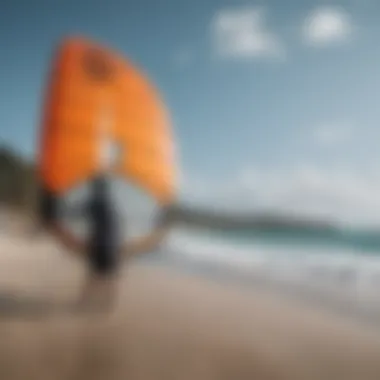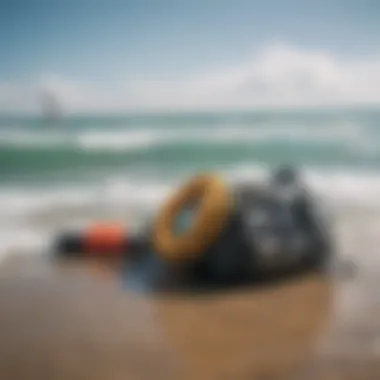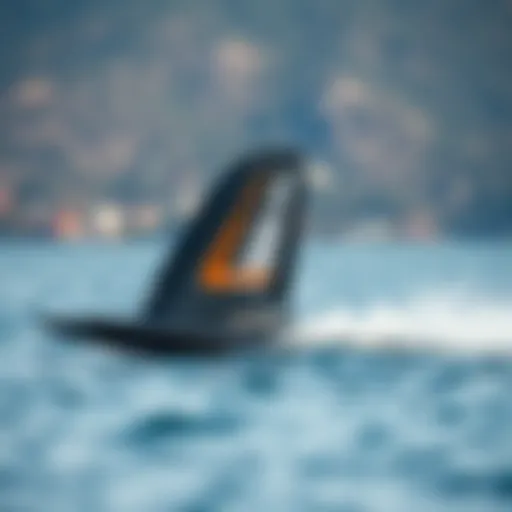Protective Storage Cases for Kiteboarding Gear


Intro
Protecting your kiteboarding gear is crucial, especially when you think about the toll that travel, storage, and the elements can take on your equipment. Kiteboards, kites, lines, and harnesses represent a significant investment, and ensuring they remain in top condition extends their life and saves you from costly repairs or replacements down the line. Understanding the intricacies of protective storage cases can make all the difference for kiteboard enthusiasts from novices to seasoned pros.
In this article, we'll dissect various storage solutions that cater to kiteboarding gear. From exploring the materials that bolster durability to strategic choices in design, we aim to equip you with the knowledge necessary to safeguard against environmental factors and wear and tear. We'll also look into selecting the right case according to specific needs—because no two kiteboarders have the same style or location of play.
Gear Insights
Kiteboarding equipment varies widely and so too do the cases designed to protect them. Exploring the right gear starts with understanding some fundamental elements.
Latest Gear Reviews
Kiteboarding gear is always evolving. Improvements in technology bring new materials and designs that enhance both performance and protection. For example, brands like Naish and Slingshot are now using reinforced fabrics that resist tearing while maintaining lightweight characteristics.
When reviewing kiteboarding storage cases, consider:
- Structure: Look for cases made with hard shells versus soft materials. Hard shell cases typically offer superior protection but can be bulky.
- Size: Ensure the case fits your specific equipment. A too-tight fit can lead to damage, while excess space might allow for unnecessary movement inside.
- Weight: Often a crucial factor for travelers. Lightweight cases can make a big difference when lugging gear through airports and other locations.
Essential Gear for Beginners
For those just starting, having the right protective gear is essential for both safety and longevity. A basic beginner’s kit would generally include:
- A reliable kiteboard case: Look for padded options to cushion against impacts.
- Kite bag: Ensure it has good storage compartments for lines and other small parts.
- Harness storage pack: One that keeps everything together and can withstand small spills or wet elements.
Don't skimp on protection from the start—protecting your investment will pay off in the long run.
Techniques and Tips
To maximize the life of your kiteboarding gear, knowing the methods of storage and maintenance is invaluable. Let’s get into some practical insights.
Maintenance Practices for Gear Longevity
Regularly cleaning and maintaining your gear can prevent premature wear and ensure safer kiteboarding experiences. Here’s how:
- After each session, rinse saltwater off your kite and board to prevent corrosion.
- Dry your gear thoroughly before packing it away. Moisture trapped in storage can create mold, weakening fabrics.
Choosing Right Case
When it comes to selecting a protective case, look for those features:
- Tough outer layer: Whether hard or semi-rigid, this will guard against impacts.
- Internal padding: Memory foam or adjustable foam can help hold your gear securely in place.
- Easy transport features: Wheels, straps, and handles can make transportation a breeze.
"Protecting your kiteboarding gear is an investment in every trip you take; quality storage cases ensure your adventures continue without a hitch."
Preface to Protective Storage Cases
In the exhilarating world of kiteboarding, safeguarding your gear is as vital as mastering the wind and waves. Kiteboarding equipment, with its intricate components and varying sizes, demands a protective storage case tailored to the intensity of its use. From surfboard-like kiteboards to delicate kites, the right storage solution not only preserves these essentials but also affects their performance and longevity.
Many kiteboarders find themselves at the mercy of unpredictable weather and rough transport conditions. One small slip or careless storage method can damage intricate bits like lines or valves. Therefore, understanding protective storage cases is essential for anyone wishing to maintain their equipment in peak condition. It ensures that every ride remains thrilling, rather than filled with the anxiety of potential damage.
When it comes to gear protection, the focus shifts not only to damage from impact but also environmental factors. Exposure to UV rays, humidity, and moisture can rapidly degrade materials, leading to costly repairs or replacements. The selection of the correct storage case acts as a fortress against these elements, allowing kiteboarders to store their gear with confidence.
Moreover, the market now flaunts a variety of storage solutions, each designed for particular needs. Whether you're a casual weekend warrior or a dedicated adventurer traveling across the globe, there’s a case tailored to your requirements. Understanding these options will help kiteboarders choose wisely, aligning their storage needs with their lifestyle.
Importance of Gear Protection
The significance of gear protection cannot be overstated. In kiteboarding, every piece of equipment plays a crucial role in performance. A damaged kite can lead to unpredictable flight patterns, while a scratched board can affect glide. Consequently, investing in a suitable protective case pays dividends in the long run.
For instance, think about a kiteboarder who frequently participates in competitions. Each event introduces a series of challenges, including transport and set-up conditions. A protective storage case mitigates the risk of wear and tear, ensuring that gear is race-ready at a moment's notice.
Additionally, gear protection is a matter of safety. Any breakdown, be it significant gear malfunction or a simple case of rupture, can potentially lead to dangerous situations while riding. The right protective case creates a buffer against these risks, allowing kiteboarders to focus on enjoying their time on the water.
Overview of Storage Solutions
In the evolving landscape of kiteboarding, a diverse array of storage solutions offers options tailored to specific needs and scenarios. Understanding these solutions is pivotal for anyone from seasoned veterans to newbies venturing into this exciting sport.
- Hard Shell Cases: These cases provide robust protection against impacts. They are ideal for those frequently traveling with gear, as they can withstand rough handling.
- Soft Shell Cases: While these do not offer the same level of impact protection as hard shell cases, they provide flexibility and lightweight portability. They typically use materials like nylon and are easier to store when empty.
- Roller Cases: Designed with mobility in mind, roller cases make transporting gear easier, especially when hiking or maneuvering through busy airports.


Each of these storage solutions has unique characteristics, and the choice largely hinges on individual preferences and specific use cases. Emphasizing quality and durability across all categories ensures that kiteboarders not only protect their gear but also gain peace of mind as they venture out onto the water.
Types of Protective Storage Cases
When kiteboarding enthusiasts invest in top-notch equipment, ensuring the safety of that gear becomes paramount. This section dives into the essential types of protective storage cases available, each designed to meet specific needs and preferences. It’s not just about tucking your gear away; it’s about understanding what kind of case will keep your kite, board, and accessories in prime condition, ready for your next adventure.
Hard Shell Cases
Hard shell cases are like the armored vehicles of the storage world. Built to withstand a battering, they offer solid protection against impacts that might occur during transport or storage. In the kiteboarding realm, where extreme conditions are a given, having a robust case can be a lifesaver for gear longevity.
Benefits of Hard Shell Storage
The best feature of hard shell storage is undoubtedly its impact resistance. When you're juggling your gear and dodging other travelers at a busy airport, the last thing you want is a flimsy case. With these sturdy fixtures, $gear is shielded from drops, knocks, and almost any kind of abuse it might encounter on the road.
Moreover, hard shell cases often feature compartments and specific padding designed for kiteboarding equipment. This tailored design aspect means that every item, from your twintip board to your harness, has a cozy little nook. Less movement within the case reduces potential damage, making this storage type a wise choice for serious boarders.
Features to Consider
When opting for hard shell cases, there are several features to consider that could make or break your experience. Look closely at the material quality; high-density polyethylene or ABS plastic might be your best bets for optimal protection.
Additionally, check the weight. Often, the more robust the case, the heavier it is, so weighing the balance between weight and protection is crucial. Some may also incorporate wheels for added mobility, but this might increase bulk.
Soft Shell Cases
Shifting gears, let’s talk about soft shell cases, which bring a different flair to gear protection. These cases encapsulate flexibility, allowing for versatility while ensuring essential protection on the go.
Advantages of Flexibility
One significant advantage is adaptability. When traveling or storing away from home, a soft shell case can sometimes fit into tighter spots better than its hard-shell relatives. They can expand and contract based on your needs, easily accommodating extra layers or additional bits of gear you spur of the moment decide to bring along.
Coupled with that is the fact that they often weigh less than hard cases, meaning they won’t weigh down your luggage allowance as significantly.
Common Materials Used
Soft shell cases typically feature materials like nylon or polyester, known for their lightweight nature. These fabrics are generally water-resistant and, when treated properly, can offer essential protection against the elements. However, keep in mind that while they’re tough, they won't offer the same level of impact resistance as hard cases. Regular maintenance, like checking for tears or worn seams, ensures longevity, and talking to fellow kiteboarders can provide insights into which brands or materials are tried and tested.
Roller Cases
Finally, we arrive at roller cases, the bane of back strain. Perfect for those who prefer effortless transport, roller cases are ideal for kiteboarders on the go.
Ease of Transportation
Picture this: you've just finished an exhilarating day on the water, and the last thing you want is to lug your gear a mile to your car. Roller cases offer the great convenience of wheels, turning what could be an exhausting journey into a leisurely stroll. You can simply roll your gear alongside you, which is especially handy in busy public transport systems or airport terminals.
Many roller cases include a sturdy pull handle, ensuring balanced distribution of weight, so you won’t feel like you're dragging a sack of potatoes.
Best Uses for Roller Cases
These cases shine most when you're embarking on trips that involve significant travel—think international kiteboarding competitions, or just a weekend getaway to the coast. They're typically spacious enough to hold your entire kiteboarding setup and then some. However, the size can become a drawback if you're trying to fit multiple cases into a small vehicle or tight storage spaces.
In summary, whether you're swayed by hard shell's durability or soft shell's adaptability, or perhaps you lean towards the convenience of rollers, understanding these types helps you make an informed choice that aligns with your kiteboarding lifestyle.
Material Considerations for Storage Cases
In the arena of kiteboarding, where the elements can be both a friend and a foe, the choice of materials used in protective storage cases takes center stage. This consideration is paramount as it directly impacts the longevity and functionality of your gear. A case that’s durable, waterproof, and lightweight can make the difference between your equipment surviving a vigorous outing or sustaining damage that could sideline your adventures.
Durability and Impact Resistance
When we talk about durability in storage cases, we're addressing how well these cases can withstand the rough and tumble of travel and storage. Kiteboarding gear tends to be an investment, and having a protective case that's built to last is essential. Materials like polycarbonate or high-density polyethylene provide robust protection.
"You want a case that's tough enough to take a hit without flinching. If it can survive being tossed in the back of a truck or dropped at the beach, you're golden."
Furthermore, impact resistance helps shield your gear from accidental drops or bumps. Think along the lines of that time you had to make a mad dash from the beach to your vehicle as the storm clouds rolled in. A well-constructed case provides peace of mind, allowing you to focus on your ride, not worrying about your setup.
Waterproof and Weather-Resistant Features
Weather can play tricks, particularly with kiteboarding – sunny one minute, downpour the next. Thus, opting for cases with waterproof or at least weather-resistant features is critical. Look for materials like waterproof zippers and seals that lock out moisture. This ensures your gear remains dry even when the clouds open up unexpectedly.
Moreover, a case that can withstand UV damage is beneficial. Extended sunlight exposure can degrade materials, causing them to crack or fade. Investing in cases treated for UV resistance means your gear is safeguarded against sun damage while waiting for the next session on the water.


Lightweight Materials for Enhanced Portability
Weight matters, especially when you’re traveling. A heavy storage case can be cumbersome, dragging you down when you're eager to hit the waves. Materials such as fiberglass or lightweight aluminum alloy not only keep the weight down but also maintain strength.
Carrying your gear should feel less like a chore and more like a smooth journey to your next adventure. A lightweight case means you can throw it over your shoulder and stroll to the beach without feeling like you're hauling a ton of bricks.
In summary, when selecting a storage case, consider durability, water resistance, and weight as your main pillars. Each element not only protects your kiteboarding investments but also enhances the overall experience, ensuring you're always prepared for the next wave.
Design Aspects of Protective Cases
When it comes to protective storage cases, thoughtful design can significantly influence the longevity and accessibility of kiteboarding gear. The right design not only safeguards the equipment from damage but also enhances user experience through functionality and convenience. Effective design should consider aspects such as ergonomics, security features, and interior customization, making them paramount for enthusiasts aiming to maintain their gear's performance.
Ergonomics and User-Friendliness
An ergonomic design helps ensure that handling and transporting case becomes a breeze, greatly enhancing the user experience. When considering ergonomics, manufacturers often include padded handles and comfortable straps that make it easier to carry even in challenging environments, like on slippery docks or sandy shores. A well-thought-out weight distribution within the case also matters. A case that’s too heavy in the front or back can lead to discomfort during transportation. This aspect is especially crucial for kiteboarders who might have to navigate uneven terrain or carry multiple pieces of gear.
Secure Closure and Locking Mechanisms
Every kiteboarder knows the value of a case that can survive the elements. Secure closure systems are critical to protect your gear from moisture, dirt, and unintentional opening during transport. Using mechanisms like cam locks, zippers with weatherproofing, or dual fastening systems can enhance security. An additional layer of peace of mind can come from tamper-proof locks or side latches that deter theft and ensure contents remain safely stowed away. This way, when you're exploring the beaches or participating in competitions, you won't lose sleep worrying about your gear.
Customizable Interiors
Having customizable interiors in a protective case is more than just a luxury; it's a fundamental requirement for many kiteboarding enthusiasts. The ability to modify the interior setup allows for personalized organization tailored to individual gear needs.
Dividers and Padding
Dividers and padding play a vital role in ensuring that different pieces of equipment remain secure and undamaged during transit. The key characteristic of these dividers is their ability to absorb shock and prevent items from shifting during movement. This is particularly beneficial for kiteboards and kites, which are often delicate and expensive. A popular choice for many is the use of foam padding, which offers a soft cradle for your gear while still being lightweight.
One unique feature of high-quality dividers is the use of Velcro, allowing users to adjust their positioning based on varying gear sizes. This flexibility can be an advantage, enabling a tailored fit for diverse items, but can also have the disadvantage of wear over time with frequent adjustments.
Adjustable Compartments
Adjustable compartments are another significant aspect that contributes to effective storage. The hallmark of these compartments is their ability to be resized according to the user's requirements. This flexibility is beneficial in accommodating not only kiteboarding equipment but also personal items, such as clothing, tools, and safety gear, especially if you're on the go.
One of the reprons of adjustable compartments is the inclusion of modular designs that allow for complete reconfiguration whenever necessary. This unique feature enhances versatility, making them a popular choice among travelers who enjoy adapting their storage case for different trips or uses. While they offer great functionality, there may be a learning curve for first-time users trying to master the layout.
"Customizable interiors transform a simple storage case into a precise tool for organization and protection, ensuring every piece of gear serves its purpose without compromise."
In essence, the design aspects of protective cases dramatically affect a kiteboarding experience. Fostering an understanding of these elements, gear owners can make informed choices, leading to better maintenance and longer-lasting equipment.
Selecting the Right Protective Case
Choosing the right protective case for your kiteboarding gear is crucial. It’s not just about stuffing everything into a bag and hoping for the best. A good case can make all the difference in preserving the integrity of your equipment, ensuring it’s ready to perform at its peak when you need it. Selecting the right storage solution involves understanding various elements like gear size, type, and how you plan to use them. Here, we’ll dive deep into these facets to clarify your options.
Analyzing Gear Size and Type
When it comes to protective storage, the size and type of your gear should be at the forefront of your decision-making process. Kiteboards, for instance, come in different sizes and shapes. A case that fits one type may not suit another. It's essential first to measure your gear accurately before zeroing in on a case. If your board measures 135 centimeters, you'll need a case specifically designed to accommodate that dimension, leaving room for padding and extra protection.
Consider the overall profile of your gear, too. Are you storing a larger twin tip board or a smaller directional one? Some cases offer adjustable compartments. Those can be fantastic as they allow you to rearrange the padding to fit your specific items snugly, avoiding any unnecessary movement during transit.
Understanding Usage Scenarios
The way you intend to use your protective case will greatly influence your choice.
Travel Needs
When traveling, the stakes are higher when it comes to gear protection. Travel needs dictate that your kiteboarding storage must stand up against the rigors of transport—think ramp bumps and baggage handlers who might not treat your equipment with utmost care. Look for cases with reinforced corners and wheels; these features minimize the risk of damage. In this context, a hard shell case might be worth considering due to their robust nature.
Additionally, some cases are designed to offer extra security features, like integrated locks or tamper-proof zippers, which can be particularly beneficial if you frequently travel through busy airports. The key characteristic of travel-friendly cases is their ability to absorb knocks, preventing those annoying dings and scratches that can affect both performance and value.
However, do keep in mind that these heavy-duty cases can bulk up your luggage and eat into your weight allowance.
Storage at Home
For those who prefer to store their gear at home, the storage at home scenario plays out quite differently. Unlike travel, you'll likely not be as concerned about ruggedness but rather about organization and space-saving.
Cases designed for home use often come with modular designs. These can be stacked or placed in corners, maximizing available space. A unique feature here is the inclusion of shelves or compartments tailored for different types of equipment—think separate sections for your board, harness, and lines.


Moreover, handling can be a breeze, with some cases providing side handles or shoulder straps that ease lifting and maneuvering. One disadvantage is, however, that home storage cases might not offer the same level of impact resistance. You won't need them to be as tough since they won’t face the same wear and tear as when you are on the go. Still, an adequately designed home case will keep dust and moisture at bay, prolonging the life of your gear.
In summary, understanding your gear's size and the scenarios in which you'll use the case will lead you to the right protective solutions, ensuring your kiteboarding equipment remains in top-notch condition.
Impact of Environmental Factors on Gear Preservation
In kiteboarding, preserving your gear is just as important as mastering the wind and waves. Environmental factors can significantly impact the longevity of your equipment. Understanding the elements at play can help kiteboarders, instructors, and hobbyists alike make informed choices about protective storage. Protecting gear from harsh environments is not merely about aesthetics; it's about ensuring performance and safety every time you hit the water.
UV Damage from Sun Exposure
One of the primary threats to kiteboarding gear is ultraviolet (UV) radiation. Extended exposure to the sun can degrade materials, weaken structural integrity, and accelerate wear and tear. For instance, most kites are constructed from fabrics that may suffer when left out in direct sunlight for extended periods. After a few seasons of leaving your kite in the sun, you might notice that it becomes less vibrant, loses strength, or even develops patches of brittleness.
To combat this, invest in high-quality protective storage cases designed with UV-resistant materials. Look for features such as:
- UV-protective coatings: These coatings can shield your gear from harmful rays, effectively reducing the chances of damage.
- Reflective exteriors: Cases that reflect sunlight can keep the internal environment cooler.
- Protective covers: High-quality tarps or specialized covers can create an extra layer of defense when storing equipment outdoors.
Using the right protective measures can save you from costly replacements and ensure that your gear remains in prime condition for those thrilling rides on the water.
Humidity and Moisture Concerns
Another lurking danger comes from humidity and moisture, especially if you live in coastal areas or regions prone to heavy rainfall. Kites, boards, and other accessories can absorb moisture, leading to mold, mildew, and weakened materials. Imagine pulling out your kite only to find it smelling musty or seeing the fabric starting to wear in spots due to unseen moisture.
Key ways to mitigate moisture-related damage include:
- Drying gear before storage: Ensure your equipment is completely dry before putting it away. Water left to sit can be a breeding ground for mold.
- Using moisture-absorbing products: Silica gel packets or other desiccants can be particularly effective in draw moisture away in enclosed storage areas.
- Ventilation: Cases that incorporate ventilation designs allow for air circulation, preventing moisture build-up.
"An ounce of prevention is worth a pound of cure." This adage rings true when considering how environmental factors can affect gear protection.
By paying attention to UV exposure and managing humidity, kiteboarders can extend the lifespan of their cherished equipment. As a result, you'll not only keep your gear in prime condition but also enhance your riding experience on both calm and challenging days.
Maintenance Tips for Protective Cases
Taking care of your protective storage cases is just as vital as selecting the right one. The longevity of the case and, by extension, the safety of your kiteboarding gear, hinges on proper maintenance. Adopting a regular cleaning regimen and conducting routine inspections can drastically improve not only the durability of your storage solution but also ensure that your equipment remains in peak condition.
Keeping your cases in top shape fosters a protective barrier against impacts, moisture, and dust. Moreover, taking the time to maintain your gear storage can save a lot of costs down the road by reducing the likelihood of needing replacements or repairs.
Regular Cleaning and Care
Many kiteboarders overlook the cleaning aspect of their storage cases, but this can lead to gradual deterioration. Depending on the material, certain cases attract dirt and grime, which can wear them down over time. Here’s a few pointers to keep in mind:
- Material-Specific Cleaning: Soft shell cases may require gentle cleaning with mild soap and warm water. Hard shell cases can often be wiped down with a soft cloth. Always check the manufacturer's recommendations for guidance.
- Dry Thoroughly: After washing, ensure that the case dries completely before storing gear inside. Moisture trapped inside can encourage mold or mildew growth, both of which can spell trouble for your equipment.
- Use Protectants: For cases made of plastic or nylon, consider applying a protective spray or sealant. This can help resist dirt sticking to the surface and might even provide some additional UV protection.
Maintaining a routine cleaning schedule—such as after every few trips out—makes it easier to stay on top of this task, preventing buildup before it becomes a bigger issue.
Routine Inspections for Damage
Regular inspections play a significant role in maintaining the integrity of your protective storage cases. A case that looks fine from the outside might be hiding hidden scratches or cracks that could lead to functional problems.
Here’s how to go about it:
- Check the Exterior: Look for any visible signs of damage like scratches, dents, or cracks. These can evolve into larger problems if neglected.
- Inspect Hinges and Locking Mechanisms: Ensure that hinges are functioning smoothly and locks engage properly. Damage to these parts can frustrate access to your gear when you need it most.
- Examine Interior Padding and Dividers: If your case has removable dividers or padding, inspect them for wear or tear. Damaged dividers may not offer the protective barrier needed for your kiteboarding gear.
- Assess Overall Size and Fit: While inspecting, consider whether your gear fits snugly in the case. A too-loose fit can lead to unnecessary movement during transport, risking impact damage.
By keeping a watchful eye on your protective storage cases, you can catch potential issues long before they turn into costly replacements. Taking these small, preventive measures can substantially enhance the longevity of your storage solutions and protect your cherished kiteboarding gear.
"An ounce of prevention is worth a pound of cure."
Ending
In the realm of kiteboarding, a sport that thrives on adventure and excitement, the significance of protective storage cases cannot be overstated. These essential tools play a pivotal role in ensuring that equipment remains in optimal condition, unaffected by the elements or the rigors of travel. Today’s kiteboarders, whether they’re seasoned professionals or eager novices, must grasp the implications of gear protection deeply.
Summarizing Key Takeaways
When reflecting on the entire discourse, several key points emerge, underscoring the importance of selecting the right protective storage case:
- Durability Matters: Investing in robust materials not only shields gear from physical impacts but also prolongs usability. Cases made of sturdy plastics or reinforced fabrics can withstand considerable wear.
- Waterproof Features: Since kiteboarding is an outdoor sport primarily involving water, waterproof cases provide an invaluable layer of protection against unexpected splashes or rain.
- Design and Ergonomics: A well-designed case isn’t just about looks; ergonomic considerations enhance user experience. From easy-carry handles to padding to safeguard delicate components, thoughtful design can save time and trouble.
- Environmental Impact: The influence of UV rays and humidity is clear. Proper storage cases can mitigate the damaging effects of sun exposure and moisture, preventing deterioration of equipment.
- Regular Maintenance: Just having a case isn’t a silver bullet. Ongoing care is necessary—regularly cleaning and checking for any signs of wear can make a significant difference in gear preservation.
In essence, protective storage cases should be viewed as an investment into the longevity of one’s kiteboarding gear. This awareness is crucial for kiteboarders dedicated to enjoying their sport to the fullest.
Future Trends in Protective Gear Storage
Looking ahead, the landscape of protective gear storage is poised for innovation and growth. Here’s what could be on the horizon:
- Smart Storage Solutions: Imagine storage cases equipped with smart technology, perhaps even sensors that track environmental conditions. These could alert users about moisture levels or UV exposure, enabling better decision-making about gear safety.
- Sustainable Materials: The kiteboarding community is increasingly leaning towards eco-friendly products. Expect to see more protective cases emerging that utilize biodegradable or recyclable materials, marrying quality with environmental responsibility.
- Customization Capabilities: As consumers seek personalized solutions, the trend for customizable interiors and exteriors is gaining traction. Modular compartments allow users to tailor their space according to specific gear, enhancing organization and efficiency.
- Enhanced Portability Options: As travel remains a big part of kiteboarding culture, future cases might incorporate innovations like lightweight designs without compromising durability, or better wheels for effortless maneuverability.
By keeping an eye on these emerging trends, kiteboarders can stay ahead of the curve, ensuring their equipment is more than just protected—it's preserved for many thrilling rides to come.















